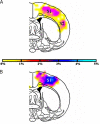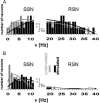Baseline brain energy supports the state of consciousness
- PMID: 19549837
- PMCID: PMC2708743
- DOI: 10.1073/pnas.0903941106
Baseline brain energy supports the state of consciousness
Abstract
An individual, human or animal, is defined to be in a conscious state empirically by the behavioral ability to respond meaningfully to stimuli, whereas the loss of consciousness is defined by unresponsiveness. PET measurements of glucose or oxygen consumption show a widespread approximately 45% reduction in cerebral energy consumption with anesthesia-induced loss of consciousness. Because baseline brain energy consumption has been shown by (13)C magnetic resonance spectroscopy to be almost exclusively dedicated to neuronal signaling, we propose that the high level of brain energy is a necessary property of the conscious state. Two additional neuronal properties of the conscious state change with anesthesia. The delocalized fMRI activity patterns in rat brain during sensory stimulation at a higher energy state (close to the awake) collapse to a contralateral somatosensory response at lower energy state (deep anesthesia). Firing rates of an ensemble of neurons in the rat somatosensory cortex shift from the gamma-band range (20-40 Hz) at higher energy state to <10 Hz at lower energy state. With the conscious state defined by the individual's behavior and maintained by high cerebral energy, measurable properties of that state are the widespread fMRI patterns and high frequency neuronal activity, both of which support the extensive interregional communication characteristic of consciousness. This usage of high brain energies when the person is in the "state" of consciousness differs from most studies, which attend the smaller energy increments observed during the stimulations that form the "contents" of that state.
Conflict of interest statement
The authors declare no conflict of interest.
Figures




References
-
- Posner MI, Raichle ME. Images of Mind. New York: Scientific American Library; 1994.
-
- Fodor J. The Mind Doesn't Work That Way: The Scope and Limits of Computational Psychology. Cambridge, MA: MIT Press; 2000.
Publication types
MeSH terms
Grants and funding
LinkOut - more resources
Full Text Sources

